ALOK S. BANSAL, LOUIS K. CHANG, AND RAHUL N. KHURANA
QUESTIONS
QUESTIONS 1–4 A 45-year-old male complains of slowly progressive decreased vision in his left eye for 2 months. Visual acuity is 20/200. His fundus examination and OCT are shown in Figures 12-1A and B.
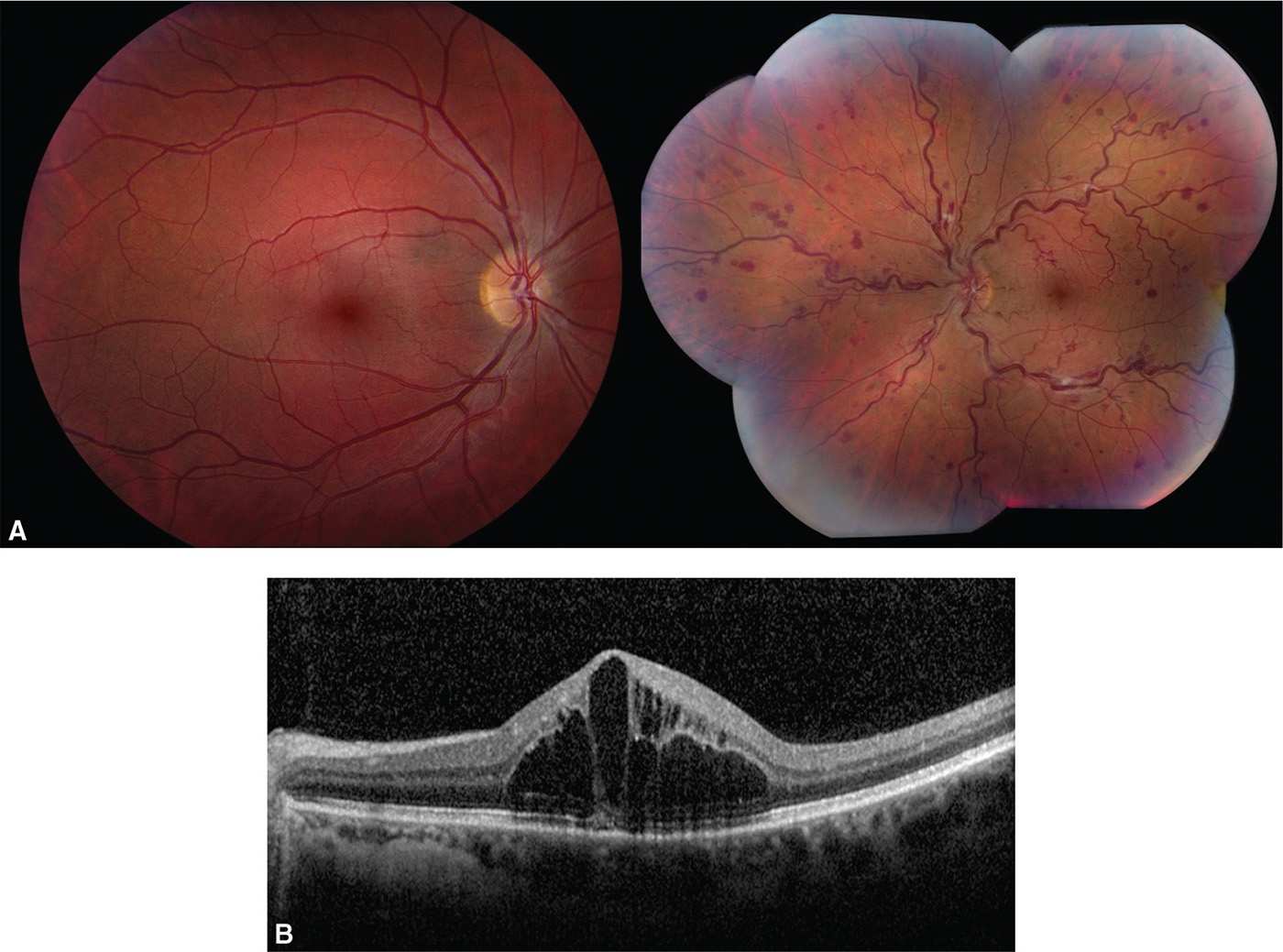
1 Which of the following best represents the pathophysiology of this patient’s condition?
A) Embolic phenomenon
B) Thrombosis at the level of the lamina cribrosa
C) Carotid stenosis
D) Compression of the central retinal vein due to an atherosclerotic arteriole
2 All of the following would be acceptable in the management of this patient except:
A) dexamethasone intravitreal implant (Ozurdex™)
B) vitrectomy with sheathotomy
C) intravitreal anti-VEGF agent
D) gonioscopy
3 Which of the following is the most serious vision-threatening complication of this condition?
A) Cataract progression
B) Retinal detachment
C) Rubeosisiridis with secondary neovascular glaucoma
D) Refractive shift
4 All of the following systemic conditions may be associated with this condition, except:
A) hypertension
B) protein C/S deficiency
C) abnormal serum electrophoresis
D) low serum homocysteine
5 A 36-year-old asymptomatic male is referred by his optometrist for the following ocular findings (Fig. 12-2). All of the following historical facts may be pertinent in determining the underlying diagnosis except:
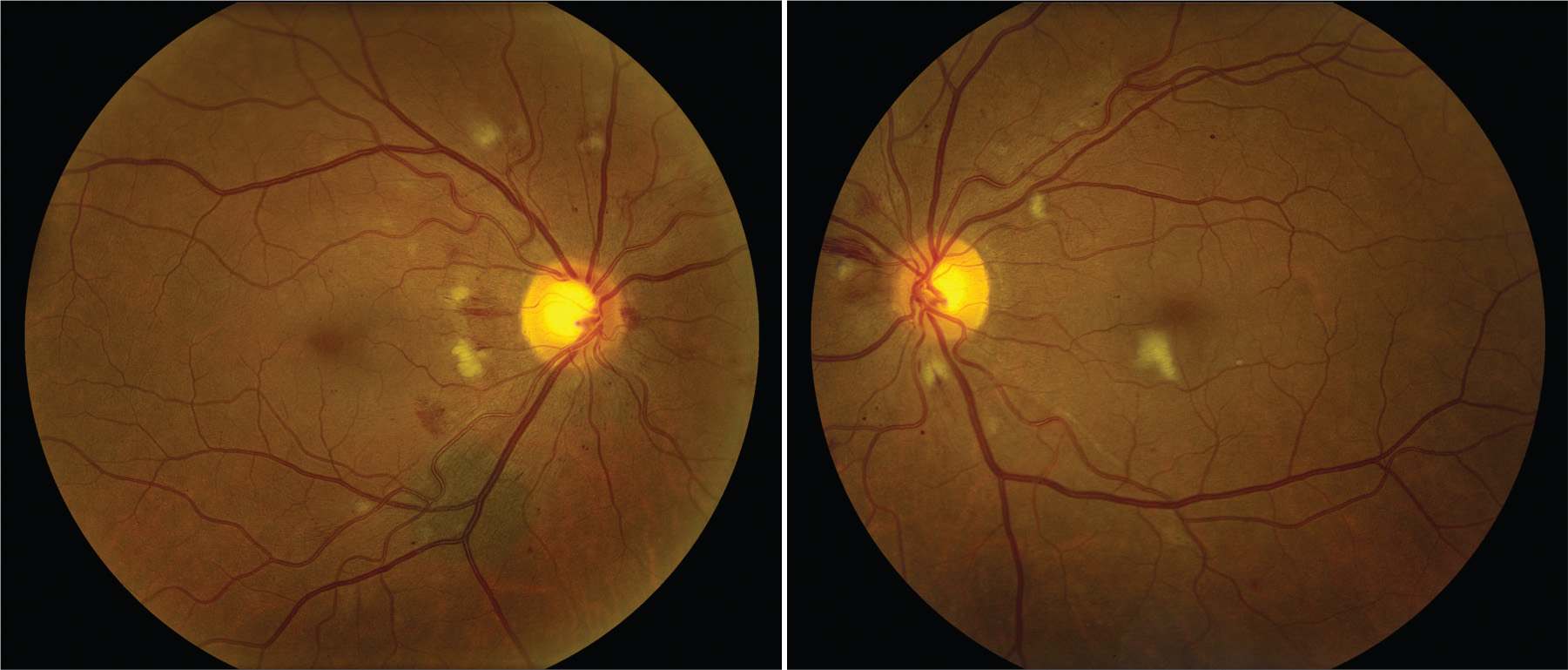
A) history of liver transplantation
B) history of multiple, nonspecific episodes of weakness and numbness
C) history of high-risk sexual behavior
D) history of polydipsia, polyphagia, polyuria
QUESTIONS 6 and 7 A 73-year-old female with a history of well-controlled diabetes recently underwent uncomplicated phacoemulsification with a posterior chamber intraocular lens and complains of blurry vision. Best-corrected visual acuity (BCVA) is 20/60. Her fluorescein angiogram and OCT are provided in Figure 12-3.
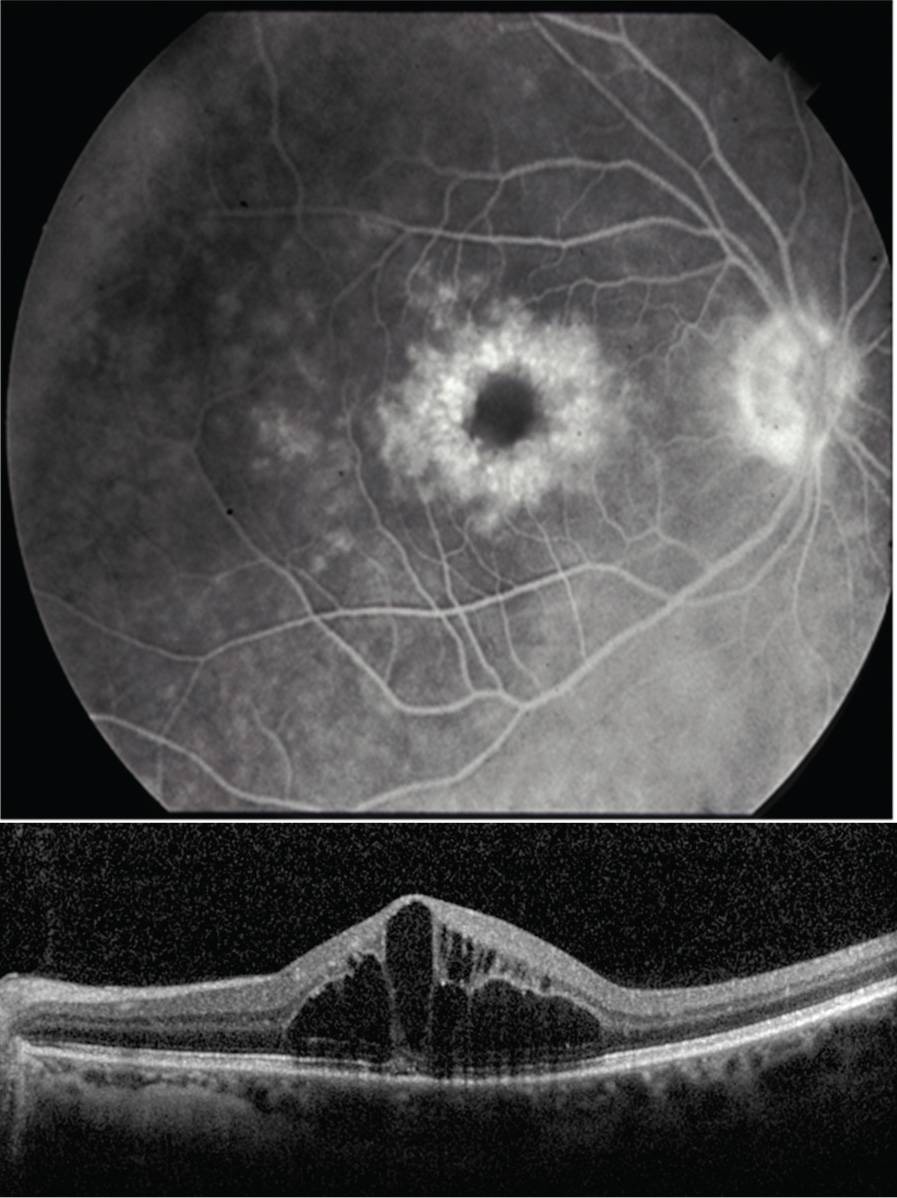
6 Which retinal layer accounts for the appearance of this patient’s vision loss?
A) Nerve fiber layer
B) Outer plexiform
C) Inner plexiform
D) Outer nuclear
7 All of the following are acceptable treatment options for this patient’s vision loss except:
A) topical prednisolone
B) topical NSAID
C) focal grid laser
D) observation
QUESTIONS 8–11 A 73-year-old Caucasian female complains of sudden, painless vision loss in her left eye. BCVA measures 20/20 in her right eye and 20/60 in her left eye. Her fundus photos and early and late fluorescein angiogram are provided in Figure 12-4A. The OCT of her left eye is provided in Figure 12-4B.
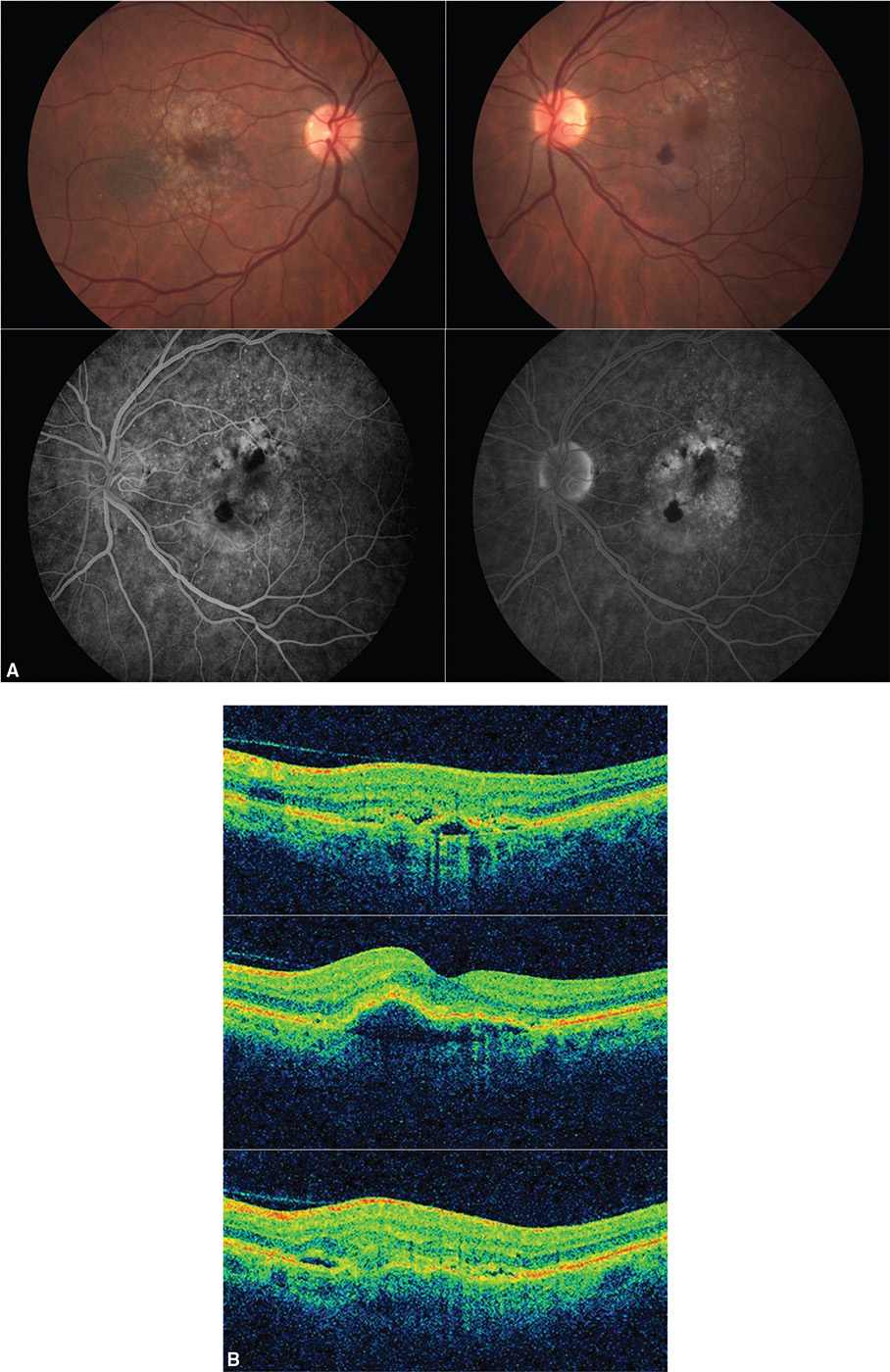
8 All of the following are FDA-approved for the treatment of her condition except:
A) intravitreal bevaziumab (Avastin™)
B) intravitreal ranibizumab (Lucentis™)
C) intravitreal aflibercept (Eylea™)
D) intravenous verteporfin (Visudyne™)
9 According to the Comparison of Age-Related Macular Degeneration Treatments Trial (CATT), which of the following is true?
A) Intravitreal bevacizumab is superior to ranibizumab
B) Intravitreal ranibizumab is superior to bevacizumab
C) Intravitreal bevacizumab is safer than ranibizumab
D) Intravitreal bevacizumab is noninferior to ranibizumab
10 What is the approximate incidence of postintravitreal injection endophthalmitis?
A) 1 in 7,500
B) 1 in 2,500
C) 1 in 10,000
D) 1 in 5,000
11 According to the ANCHOR clinical trial regarding the use of intravitreal ranibizumab for neovascluar age-related macular degeneration (ARMD), approximately what percent of patients gain at least three lines of vision after 2 years of therapy?
A) 10%
B) 50%
C) 90%
D) 30%
12 A 33-year-old female complains of bilateral vision loss for 4 months. Visual acuity measures CF and 20/100. Her fundus photos are provided in Figure 12-5. All of the following may be associated with the development of this condition except:
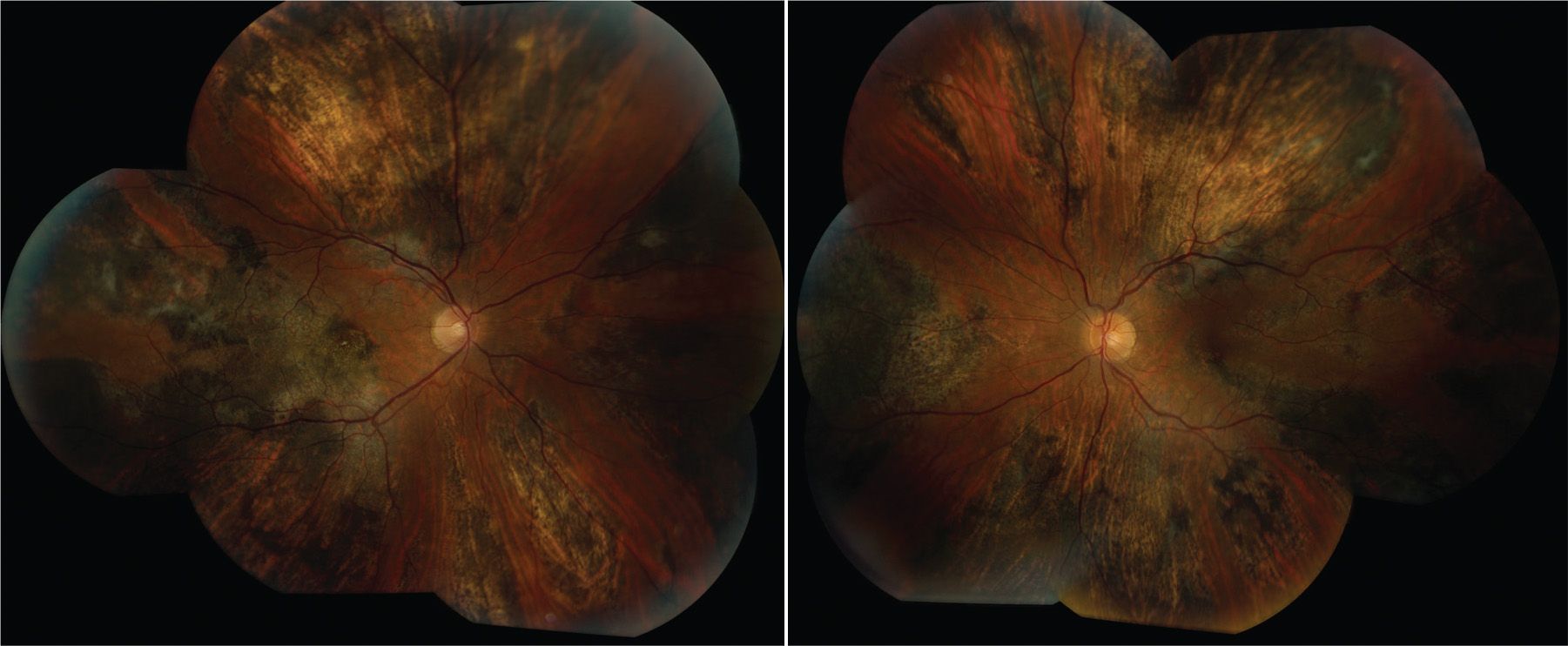
A) disseminated intravascular coagulation
B) polyarteritisnodosa
C) retinitis pigmentosa (RP)
D) toxemia of pregnancy
QUESTIONS 13–17 Match the following descriptions of the retinal layers with their corresponding labeled spectral-domain OCT layers on Figure 12-6.
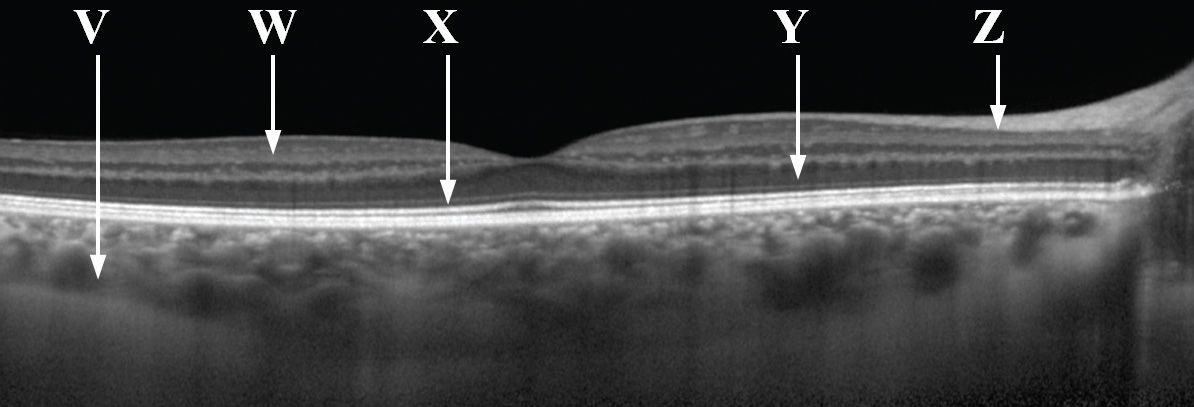
13 This layer represents the junction between the photoreceptor inner and outer segments:
A) Z
B) X
C) V
D) W
14 A cotton-wool spot represents an infarct of this layer:
A) X
B) Y
C) V
D) Z
15 This layer is responsible for the major source of nutrition of the retinal pigment epithelium (RPE):
A) Z
B) W
C) V
D) Y
16 This layer represents interconnections between photoreceptors, bipolar, and horizontal cells:
A) W
B) Y
C) W
D) Z
17 The cell bodies in this layer have their axons in the nerve fiber layer:
A) W
B) V
C) Y
D) X
QUESTIONS 18–20 A 34-year-old white man reports that he has had floaters for 1 week. His fundus examination is shown in Figure 12-7.
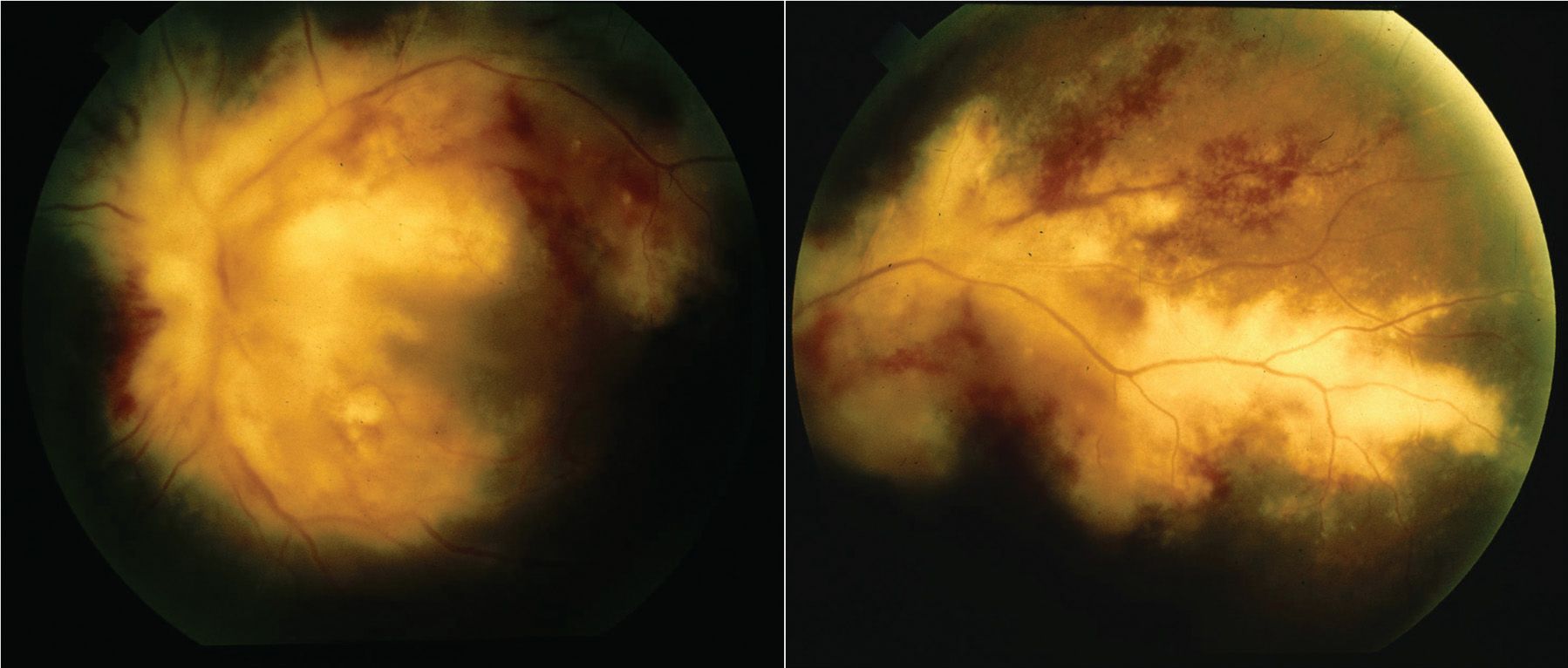
18 Which systemic condition is most relevant to the diagnosis?
A) Insulin-dependent diabetes mellitus since age 11
B) Uncontrolled hypertension
C) Recurrent pneumonia, weight loss, and vascular skin lesions
D) Sickle cell anemia
19 Which of the following would be seen histopathologically?
A) Retinal necrosis
B) Loss of pericytes
C) Macroaneurysms
D) Thickening and excrescences on Bruch membrane
20 What ocular complication may be associated with this condition?
A) Retinal detachment
B) Neovascular glaucoma
C) Neovascularization of the optic disc
D) Siegrist streaks
QUESTIONS 21 and 22 A 60-year-old woman with diabetes mellitus and hypertension reports having difficulty reading for the past 4 months. Her visual acuity is 20/25. Her fundus photograph, fluorecein angiogram, and OCT are shown in Figure 12-8.
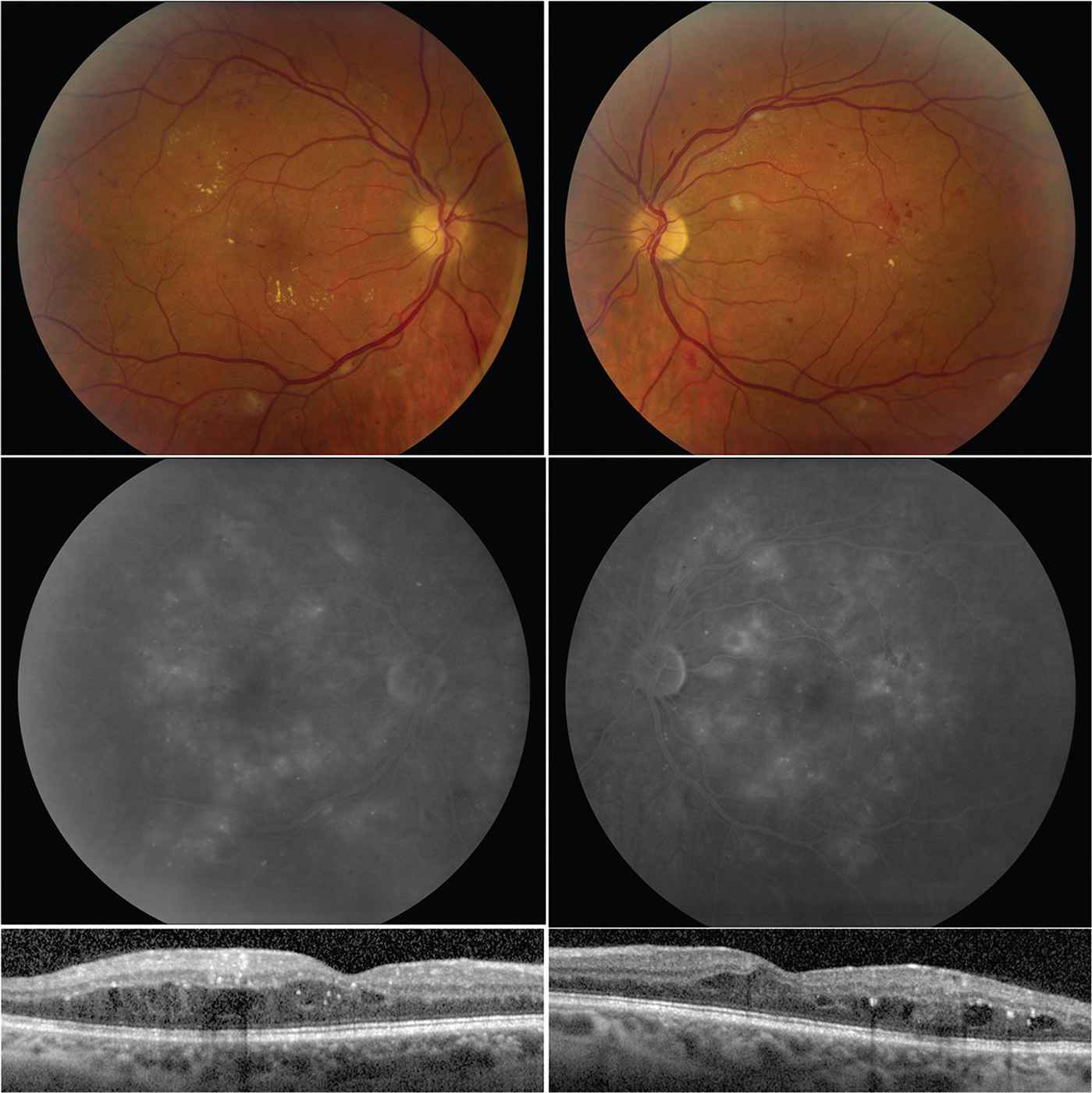
21 According to the Early Treatment of Diabetic Retinopathy Study (ETDRS), which one of the following is considered clinically significant diabetic macular edema?
A) Hard exudates within 500 µm of the fovea
B) Retinal thickening greater than 1 disk area in size and within 1 disk diameter of the center of the fovea
C) Diffuse leakage on fluorescein angiography
D) A circinate ring of exudates located 2 disk areas from the fovea
22 All of the following would be acceptable in the management of this patient except:
A) close observation with reevaluation in 2 months
B) intravitreal anti-VEGF agent
C) panretinal laser photocoagulation
D) focal laser photocoagulation
QUESTIONS 23–25 A 7-year-old girl reports having poor vision for 2 weeks. She presents with a fundus as shown in Figure 12-9.
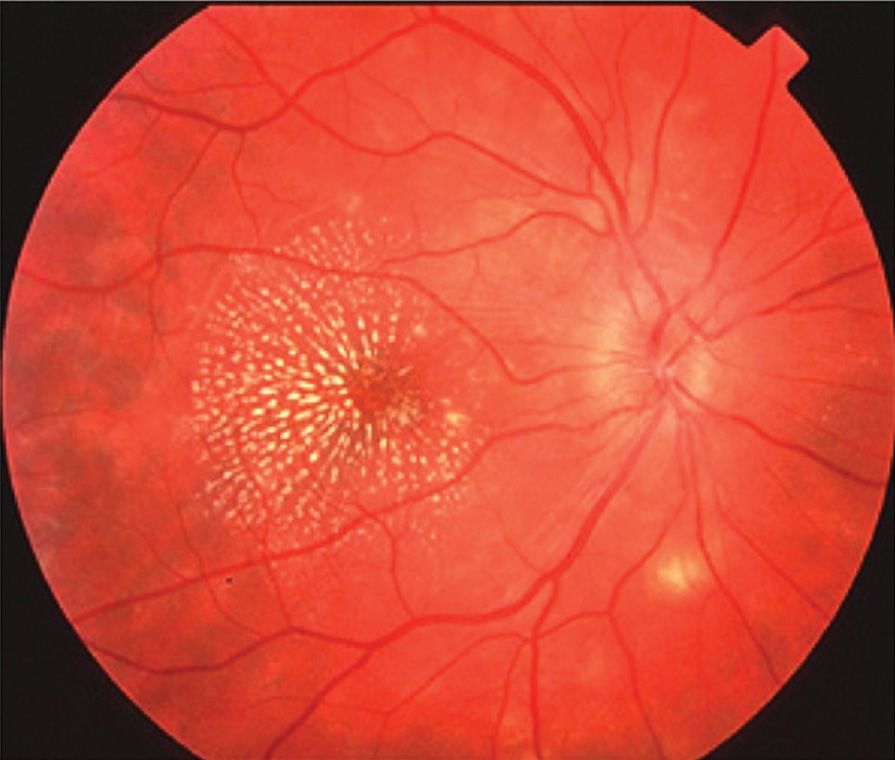
23 What historical information might be helpful in the diagnosis?
A) Prematurity with low birth weight
B) Juvenile-onset diabetes mellitus
C) Blunt trauma to orbit with a soccer ball
D) A pet cat at home
24 What laboratory studies are appropriate?
A) Urinalysis, stool for ova and parasites
B) Complete blood count (CBC), venereal disease research laboratories (VDRL) test, toxoplasma titer, viral titer screen, Bartonella IgG, and IgM
C) Antinuclear antibodies, serum protein electrophoresis (SPEP)
D) Lipoprotein, computed tomography (CT) of head and orbits
25 What treatment would you offer?
A) Triple sulfa antibiotics
B) Vitrectomy
C) Observation
D) Laser photocoagulation
26 Which one of the following about Coats disease is true?
A) Usually bilateral
B) Associated with microphthalmia
C) Bimodal age distribution
D) Equally common between males and females
27 Which one of the following conditions has been associated with foveal hypoplasia?
A) Choroideremia
B) Aniridia
C) Juvenile X-linked retinoschisis (JXLR)
D) Tay–Sachs disease
QUESTIONS 28–30 A 60-year-old white woman reports having poor vision in her left eye for 4 months. Her fundus photo and OCT are shown in Figure 12-10.
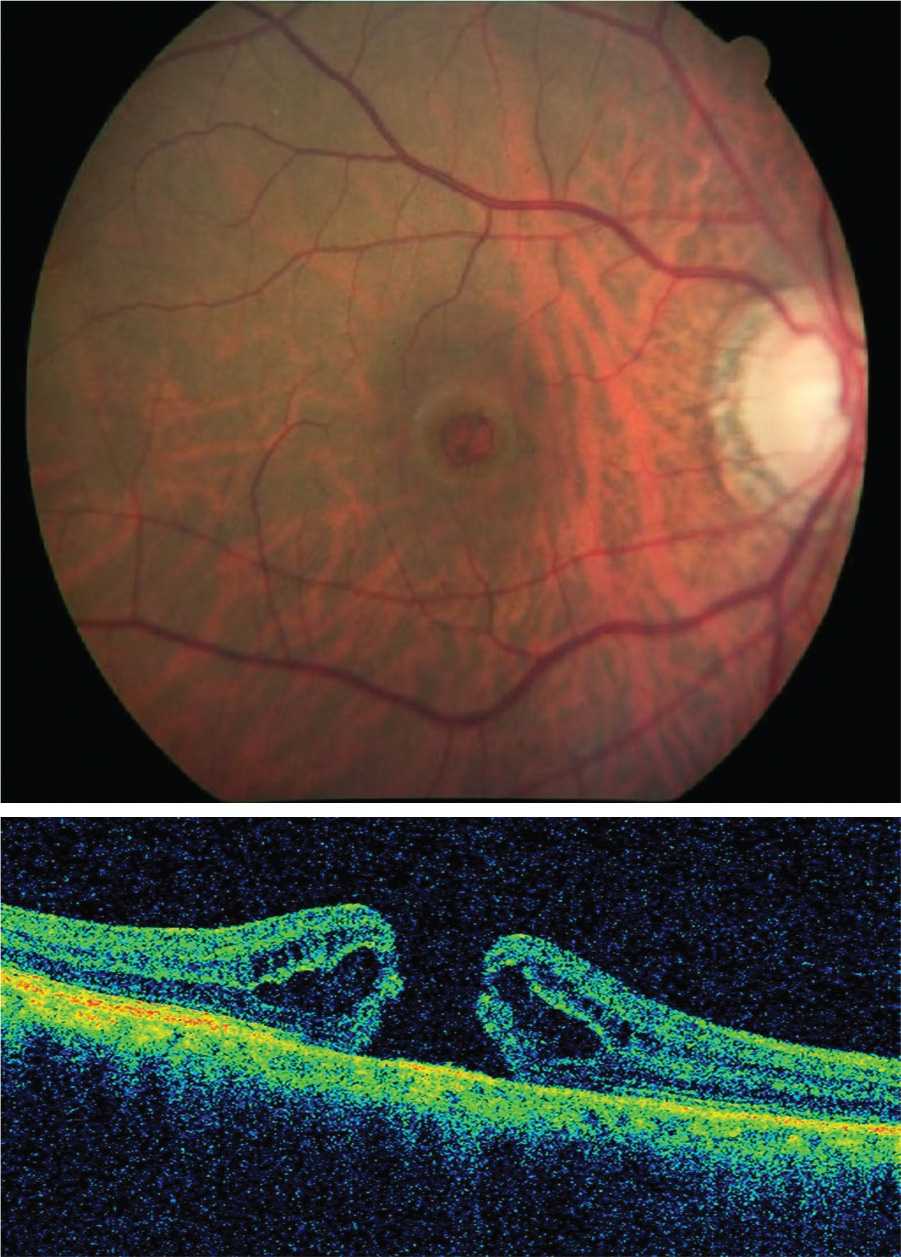
28 What is her diagnosis?
A) Retinal detachment
B) Macular hole
C) Cystoid macular edema (CME)
D) Epiretinal membrane
29 What would fluorescein angiography show?
A) Central hypofluorescence due to blockage
B) Leakage in petalloid pattern
C) Central window defect
D) Pooling of fluorescein
30 What treatment might be offered?
A) Vitrectomy with intraocular gas injection
B) Laser photocoagulation
C) Sub-Tenon steroid injection
D) Scleral buckling procedure
31 All of the following are associated with the clinical finding shown in Figure 12-11 except:
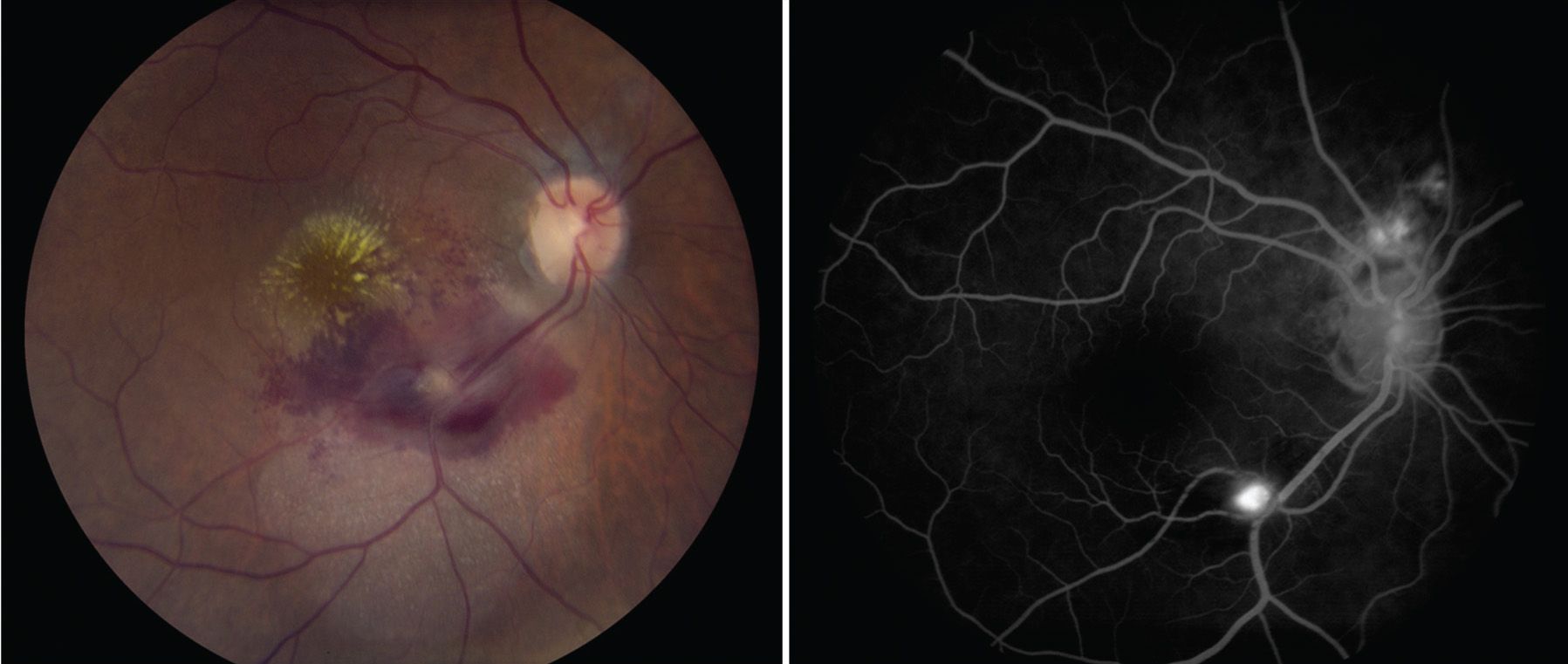
A) vitreous hemorrhage (VH)
B) hypertension
C) renal cell carcinoma
D) macular edema
32 A 54-year-old poorly controlled diabetic male presents with floaters in his left eye for 1 week. BCVA measures 20/20, right eye, and 20/80, left eye. His fundus photos and angiogram are show in Figure 12-12. According to the Diabetic Retinopathy Study, all of the following meet the high-risk criteria for significant visual loss with proliferative diabetic retinopathy (PDR) except:
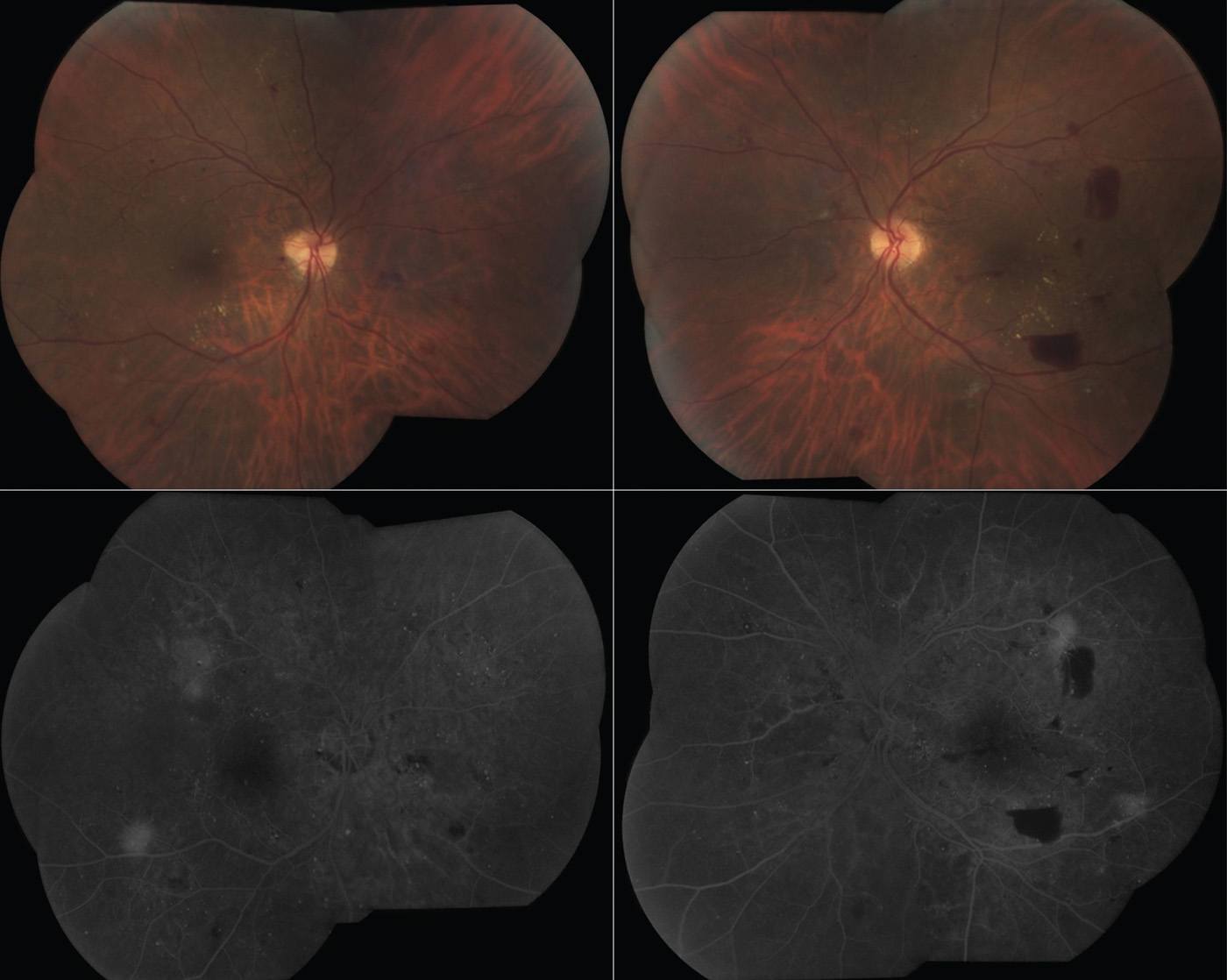
A) 1 disk area (DA) isolated neovascularization elsewhere (NVE)
B) 1/3 DA neovascularization of the disk (NVD)
C) 1/4 DA NVD with VH
D) 1/2 DA NVE with preretinal hemorrhage
33 Which one of the following may be associated with the fundus photo and angiogram shown in Figure 12-13?
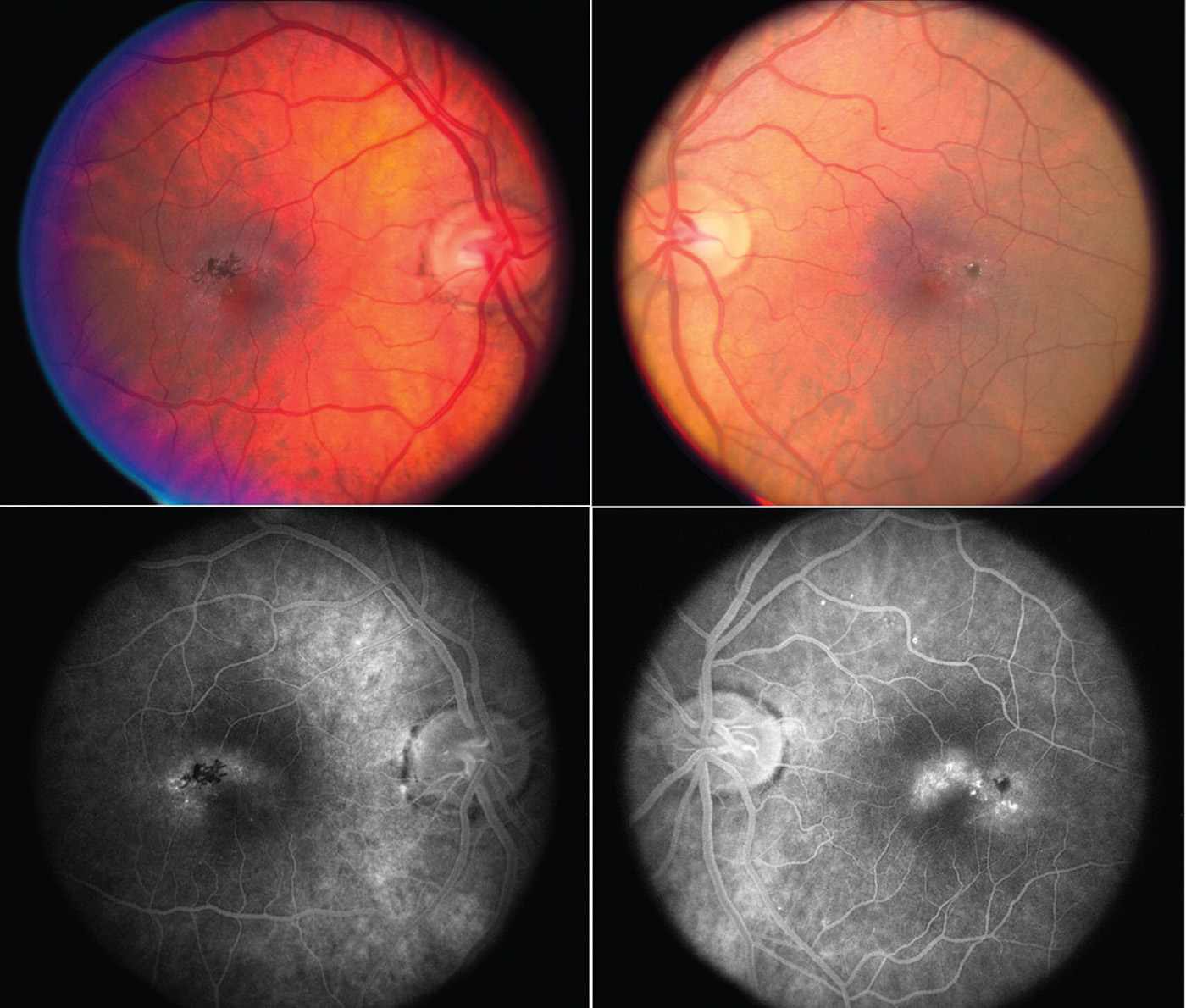
A) Neovascularization of the disk
B) Macular edema
C) Cotton-wool spots
D) Pigment epithelial detachment
QUESTIONS 34 and 35 A 34-year-old lawyer presents with 2 days of painless blurring of vision in his right eye and the fundus shown in Figure 12-14. He had a similar episode 2 years ago.
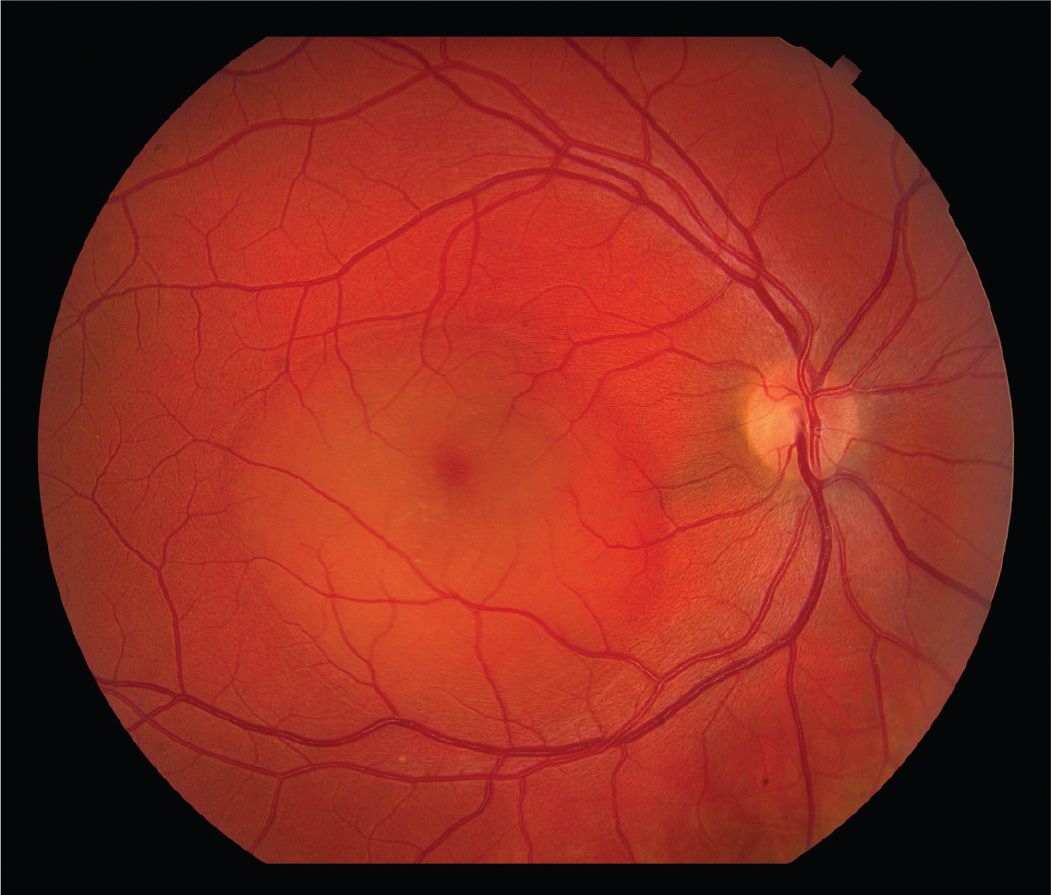
34 What would the fluorescein angiogram most likely demonstrate?
A) Diffuse choroidal oozing
B) Focal leaking hot spot
C) Lacy subfoveal choroidal neovascular membrane (CNVM)
D) Leakage off optic nerve
35 Which therapy is most appropriate for this condition?
A) Observation
B) Panretinal photocoagulation (PRP)
C) Posterior sub-Tenon injection of corticosteroids
D) Scleral buckle and posterior drainage of fluid
36 According to the Endophthalmitis Vitrectomy Study:
A) All patients with acute endophthalmitis benefit from immediate vitrectomy.
B) Systemic antibiotics are of benefit in the final visual outcome and should be instituted in addition to intravitreal antibiotics.
C) Vitreous biopsy and injection of intravitreal antibiotics in patients with better than hand-motions vision did equally well as patients with immediate vitrectomy and injection of intravitreal antibiotics in final visual outcome.
D) In patients with light-perception only vision, neither vitrectomy nor vitreous tap was of significant benefit in final visual outcome.
QUESTIONS 37 and 38 A 25-year-old woman presents with sudden, painless vision loss in her right eye. Her visual acuity measures HM with a relative afferent pupil defect. Her fundus photos, angiogram, and OCT are shown in Figure 12-15.
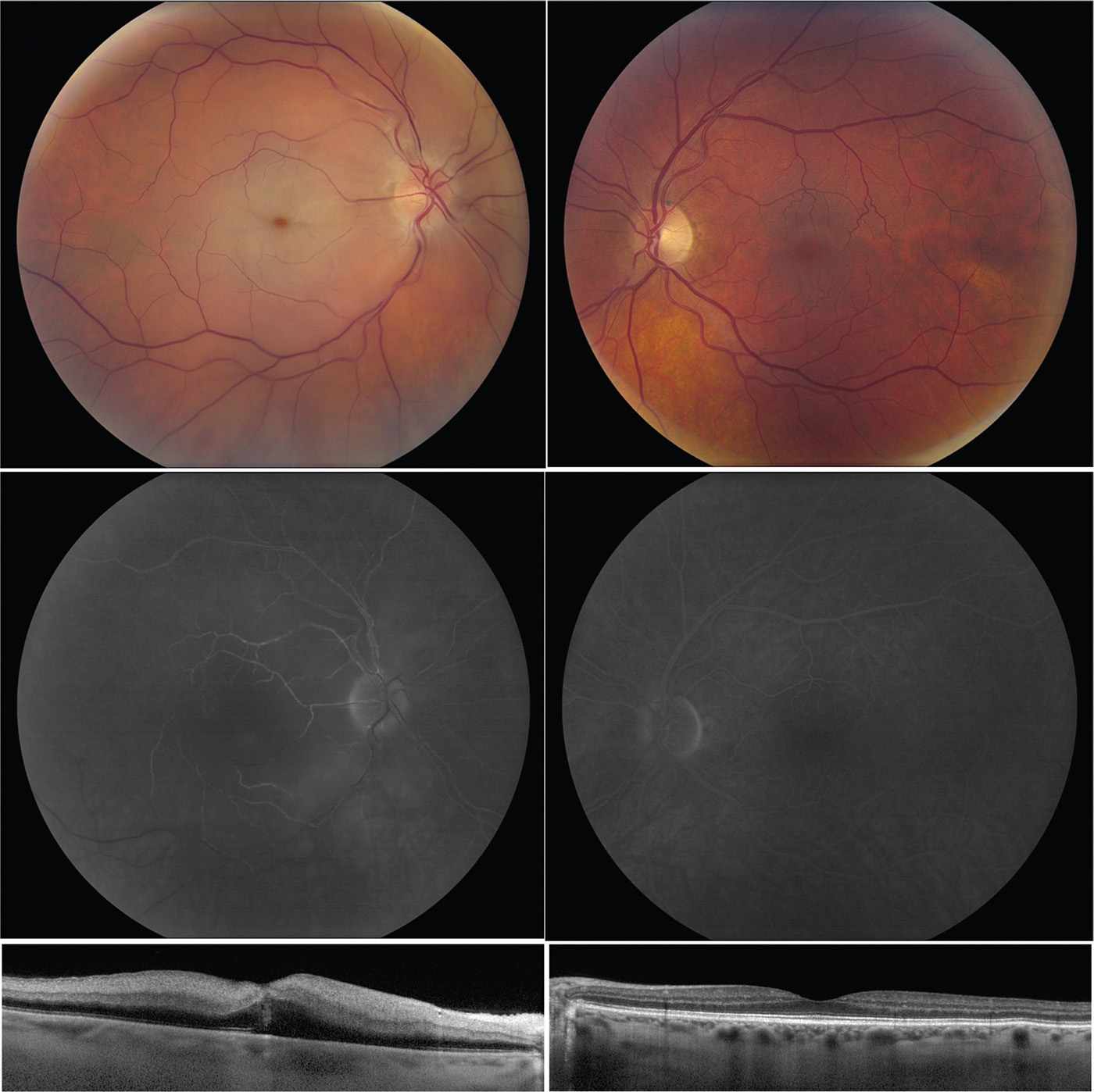
37 Which one of the following is the least likely etiology of her condition?
A) Cardiac emboli
B) Oral contraceptives
C) Migraine
D) Atherosclerosis
38 What ocular complication may result after this condition?
A) Corneal edema
B) Staphyloma
C) Rubeosis iridis
D) CNVM
39 All findings are associated with sickle cell disease except:
A) Dalen–Fuchs nodules
B) sunbursts
C) sea fan neovascularization
D) salmon patch hemorrhages
40 Degeneration of which retinal cell is the principal cause of RP?
A) Retinal pigment epithelium (RPE)
B) Rods
C) Ganglion cells
D) Cones
41 All of the following are true regarding sympathetic ophthalmia except:
A) It may occur 2 years following penetrating eye injury.
B) The granulomatous uveitis occurs bilaterally.
C) Histopathologically, it is a panuveitis with sparing of the choriocapillaris.
D) The only effective treatment is enucleation of the traumatized eye.
42 All of the following may develop a similar complication leading to central visual loss except:
A) presumed ocular histoplasmosis syndrome (POHS)
B) angioid streaks
C) pathologic myopia
D) nanophthalmos
43 A 62-year-old female presents with gradually progressive distortion in her right eye. Visual acuity measures 20/70. Which lesion might lead to development of the condition shown in Figure 12-16?
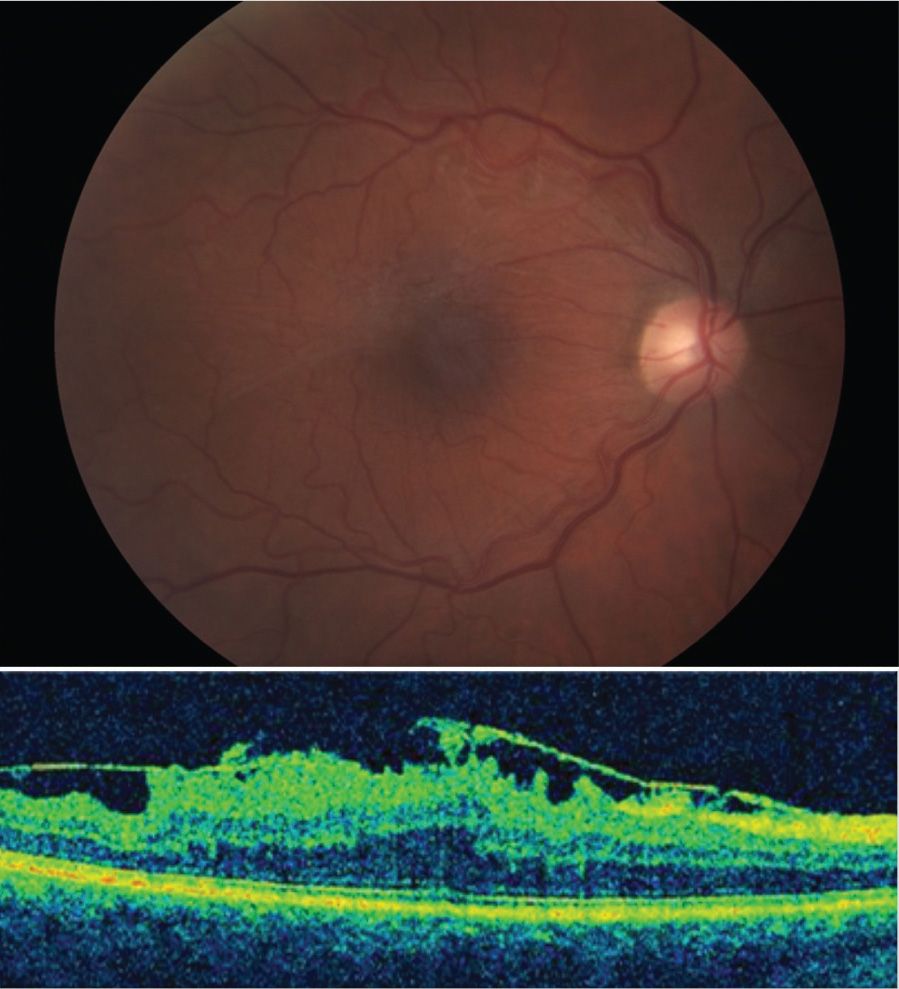
A) Cobblestone degeneration
B) Retinal break
C) Choroidal nevus
D) Bone spicule pigmentation
44 What percentage of the population will have a cilioretinal artery?
A) 85%
B) 65%
C) 45%
D) 25%
45 The CME in which one of the following conditions would have leakage on fluorescein angiography?
A) Goldmann–Favre
B) JXLR
C) Nicotinic acid maculopathy
D) Epiretinal membrane
46 All of the following may present with subretinal, intraretinal, and preretinal hemorrhage except:
A) choroidal neovascularization (CNV)
B) sickle cell retinopathy
C) trauma
D) macroaneurysm
QUESTIONS 47–50 A 48-year-old African American man comes in for a routine eye examination, and the fluorescein angiogram pictured in Figure 12-17 is obtained.
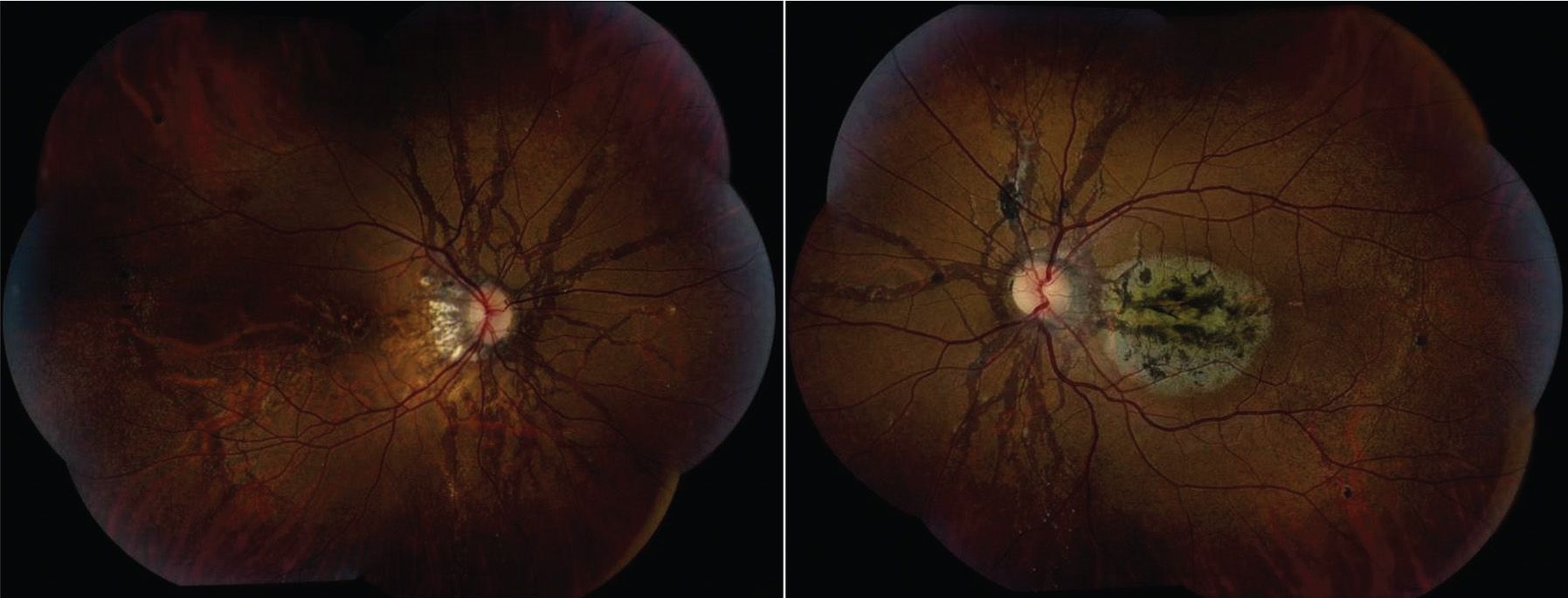
47 Each of the following historical features would be helpful in confirming the etiology except:
A) hyperextensible joints
B) fractures of both femurs
C) recent splenectomy
D) headaches and nausea
48 On further examination, this patient has areas of yellowish papular skin lesions and redundant and inelastic folds of skin on the neck and thighs. What ocular manifestation of this disease might be present?
A) Optic nerve drusen
B) Arterial macroaneurysms
C) Salmon patches
D) Blue sclera
49 Which systemic complication of this condition is possible?
A) Peripheral neuropathy
B) Gastrointestinal bleeding
C) Carotid emboli and stroke
D) Weight loss and anorexia
50 Which ocular complication may occur?
A) CNV
B) RPE degeneration
C) Retinal detachment
D) VH
51 All of the following regarding choroidal melanoma are true except:
A) The presence of lipofuscin and subretinal fluid associated with the pigmented lesion may help differentiate it from a choroidal nevus.
B) A/B-scan ultrasonography of the lesion shows low internal reflectivity.
C) The liver is the most common site of metastasis.
D) Enucleation of the affected eye decreases the mortality rate.
52 Which mucopolysaccharidosis does not cause RPE degeneration?
A) Hunter’s
B) Hurler’s
C) Maroteaux–Lamy
D) Scheie’s
53 Retinal crystals may be seen with use of all of the following medications except:
A) tamoxifen
B) canthaxanthine
C) methoxyflurane
D) chloroquine
54 Findings in Stargardt disease may include all of the following except:
A) RPE atrophy in the macula
B) nonperfusion on fluoresceinangiogram
C) yellow flecks in the macula
D) yellow flecks in the peripheral retina
55 What is the most effective method to repair retinal detachments due to cytomegalovirus (CMV)?
A) Cryopexy and an intraocular gas bubble
B) Vitrectomy and endolaser
C) Scleral buckle with drainage of subretinal fluid
D) Vitrectomy and silicone oil tamponade
56 Exudative detachments occur in all of the following conditions except:
A) Vogt–Koyanagi–Harada (VKH) syndrome
B) myopia
C) toxemia of pregnancy
D) CMV retinitis
57 A copper intraocular foreign body can cause all of the following except:
A) sunflower cataract
B) Kayser–Fleischer rings
C) suppurative endophthalmitis
D) irreversibly flat ERG
58 A 67-year-old hypertensive white man awoke with acute, painless loss of vision. Examination reveals visual acuity of hand motions and an afferent pupillary defect. The fundus is shown in Figure 12-18. Which one of the following has not been advocated as a possible treatment for this condition?

A) Hyperbaric oxygen
B) Anterior chamber tap
C) Acetazolamide and topical β-blockers
D) Anticoagulation with Coumadin
59 Which statement regarding uveal effusion syndrome is true?
A) It occurs in eyes with abnormally short axial length.
B) It is effectively prevented by using a Flieringa ring.
C) It is treated by vitrectomy to drain choroidals.
D) Risk factors include hypertension and atherosclerosis.
60 What is the treatment for traumatic macular holes?
A) Systemic corticosteroids
B) Observation
C) Scleral buckle and vitrectomy
D) Vitrectomy and gas–fluid exchange
61 Which one of the following intraocular foreign bodies would be tolerated best?
A) Sand
B) Wood
C) Brass
D) Iron
62 Commotio retinae represents:
A) retinal edema from contusion injury
B) traumatic disruption of choroidal circulation resulting in retinal edema
C) disruption of photoreceptor elements and damage to photoreceptor cells
D) retinal edema from damage to retinal vasculature
63 What is, in order of frequency, the likelihood of traumatic retinal tears after blunt ocular injury?
1. Tears around lattice
2. Giant retinal tears
3. Inferotemporal dialysis
4. Superonasal dialysis
5. Flap tears
A) 3 > 2 > 4 > 5 > 1
B) 4 > 3 > 2 > 1 > 5
C) 3 > 4 > 2 > 5 > 1
D) 4 > 2 > 3 > 5 > 1
64 All of the following about retinopathy in shaken baby syndrome are true except:
A) Intraretinal and preretinal hemorrhages are present.
B) Has a good visual prognosis with complete healing of retinal injuries
C) May also have VH
D) Similar to central retinal vein occlusion (CRVO), Purtscher retinopathy, and Valsalva retinopathy
65 Terson syndrome may have:
A) retinal hemorrhages in patients with spontaneous or traumatic subarachnoid hemorrhages
B) VH in patients with spontaneous or traumatic subarachnoid hemorrhages
C) both A and B
D) neither A nor B
66 All of the following may be the underlying cause of the fundus appearance in Figure 12-19 except?
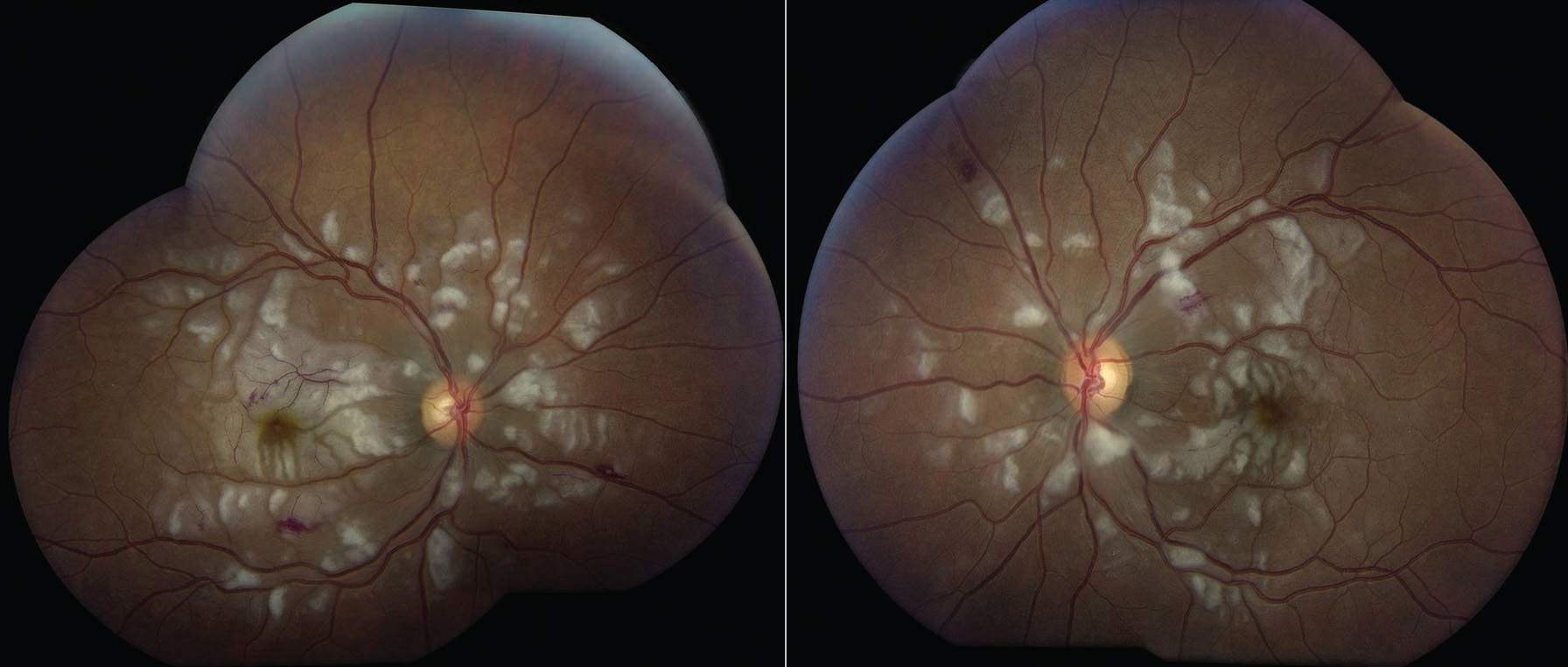
A) Severe chest compression trauma
B) Acute pancreatitis
C) Fat embolism syndrome
D) Disseminated intravascular coagulation
67 All of the following are true of the condition pictured in Figures 12-20A and B except:
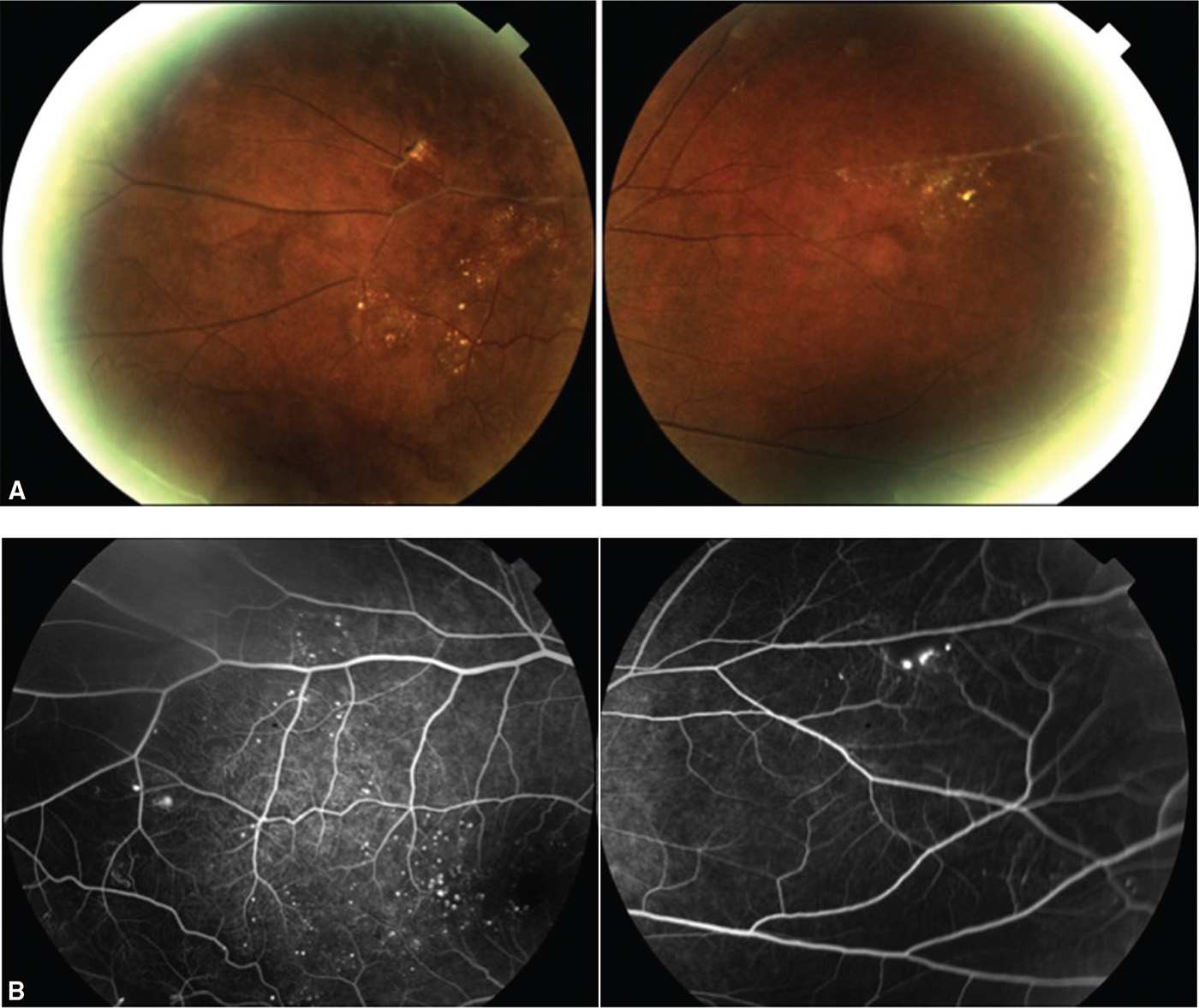
A) usually unilateral
B) increased risk of rhegmatogenous retinal detachment
C) male preponderance
D) may require treatment with laser photocoagulation
68 Persistent fetal vasculature (PFV):
A) is initially associated with a clear lens or minimal opacity that may later become densely cataractous
B) is often bilateral
C) is associated with low birth weight
D) is associated with buphthalmos
QUESTIONS 69 and 70 A 27-year-old had a ruptured right globe with uveal prolapse repaired 6 weeks before presenting with photophobia, blurry vision, and pain in the left eye.
69 Which one of the following statements regarding this patient is true?
A) Granulomatous keratic precipitates are found in both eyes.
B) Enucleation of the right eye will be beneficial in this condition.
C) This is endogenous endophthalmitis and will benefit from IV antibiotics.
D) This condition occurs in 5% of cases of penetrating ocular trauma.
70 What treatment is indicated?
A) Posterior vitrectomy of left eye
B) Oral nonsteroidal anti-inflammatory medications
C) Topical and systemic corticosteroids
D) Intravitreal injection of antibiotics
71 A 61-year-old male complains of generalized fatigue, weight loss, and fevers for several months. He has no vision complaints and visual acuity measures 20/20 OU. His fundus photo is provided in Figure 12-21. All of the following may be the cause of his underlying condition, except:
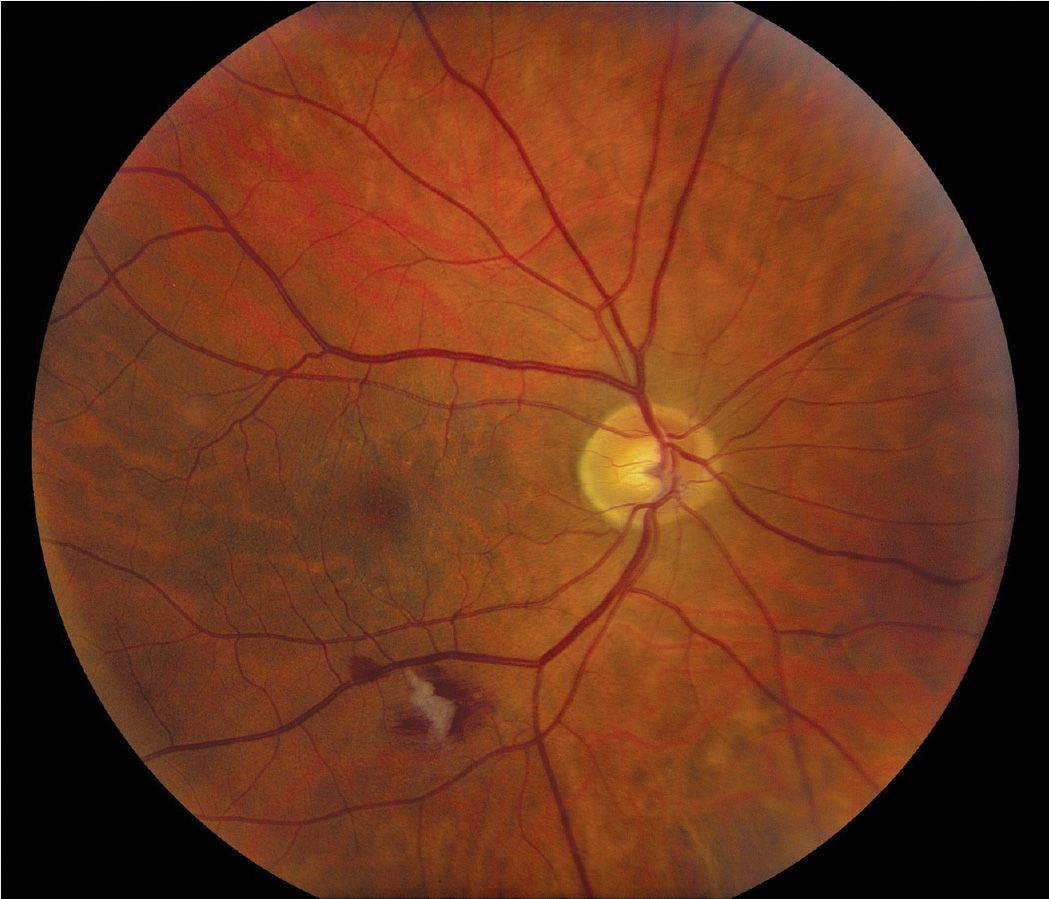
A) subacute bacterial endocarditis
B) leukemia
C) measles
D) collagen vascular disease
72 All of the following are associated with punctate inner choroidopathy (PIC) except:
A) myopia
B) female gender
C) viral prodrome
D) CNVMs
Stay updated, free articles. Join our Telegram channel

Full access? Get Clinical Tree


